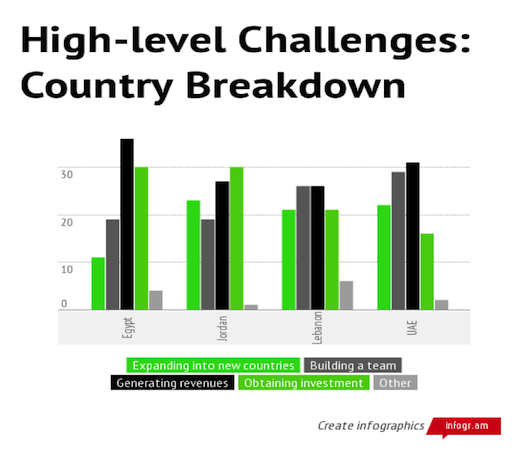What is the next step for improving funding conditions for MENA entrepreneurs?

Though the investment scene for MENA’s entrepreneurs is evolving, large gaps remain. In the 2013-2014 World Economic Forum Global Competitiveness Report, business executives surveyed from Tunisia, Morocco, Egypt, Jordan, the UAE, Saudi Arabia, Qatar, and Kuwait all rank access to financing as one of the top five problems to doing business. The World Bank, in a 2011 report, points out that bank financing for small to medium-sized enterprises is a major problem in the region; only 8% of total lending goes to SMEs.
However, the conversation on improving funding conditions for MENA’s entrepreneurs is not simply one of increasing access to funding, but also finding specific investment sizes and establishing strong relationships with investors. The Wamda Research Lab’s recent report – The Next Step: Breaking Barriers to Scale for MENA’s Entrepreneurs – suggests that additional facets to the equation need to be considered to effectively improve conditions for funding entrepreneurial ventures in MENA.

The WRL’s report is based on a survey of over 900 entrepreneurs and experts in the MENA region. It is structured around a series of questions about the most significant barriers to scaling business in the region. Respondents were asked to choose whether obtaining investment, generating revenues, building a team, and expanding geographically is their biggest obstacle to scale. Twenty-four percent of entrepreneurs and 28% of experts chose obtaining investment. At an industry-level, 30% of information and communications technology (ICT) companies surveyed, as well as 26% of scaleups (defined as a company older than three years old and with employment growth of 20% or more), also chose obtaining investment.

Regarding specific challenges to obtaining investment, 36% of entrepreneurs and 43% of experts say that the lack of venture funding in their country is their biggest hurdle. Thirty-two percent of scaleups said that the supply of venture funding in their country is too small, followed by 31% believing that investors not offering enough value beyond cash is the main issue.
In terms of individual countries, Jordanian and Egyptian entrepreneurs in our sample also point to the small supply of venture funding, with 39% of entrepreneurs choosing this option in Jordan, and 41% in Egypt. However, entrepreneurs in Lebanon and the UAE are concerned with investors not offering enough value beyond cash, the option chosen by 26% of the total surveyed in each country.

While those surveyed cited the supply of available venture funding as the most constraining to obtaining investment, during follow-up interviews, we found that the real problem was finding appropriate amounts of funding. Though new funds are seeking to fill the gap in funding, the entrepreneurs and experts interviewed said that Series A funding was lacking in MENA. Our survey results provided extra clarity to this as only 21% actually received investment of $500,000 USD or higher in 2012.
But the lack of available funding is only a surface-level diagnosis of a series of smaller problems. Although at a high level the experts and entrepreneurs surveyed both agree that the low supply of venture funding is the main obstacle to receiving investment, their answers differ on secondary matters. Thirty-one percent of experts say that entrepreneurs not understanding what investors are looking for is their biggest barrier to receiving funding, though only 8% of entrepreneurs say the same. Additionally, 30% of experts say that entrepreneurs are unable to pitch their ideas effectively; only 6% of entrepreneurs agree with this.
While more funding is clearly needed, there should be more focus on the specific types and sizes of investment that are required to improve the situation. Furthermore, knowledge sharing between experts and entrepreneurs should be encouraged. Even if more funding is made available, each group acknowledging the concerns of the other will be critical in this process.
The WRL will engage this topic of funding for MENA’s entrepreneurs in an upcoming publication, but in the meantime, what do you think? Let us know your thoughts about the need for more investment for MENA’s entrepreneurs, and what resources beyond financing are needed. How can we better tackle the regional investment gaps? Share your thoughts with us via Twitter (using the hashtag #WamdaResearch) or Facebook.


